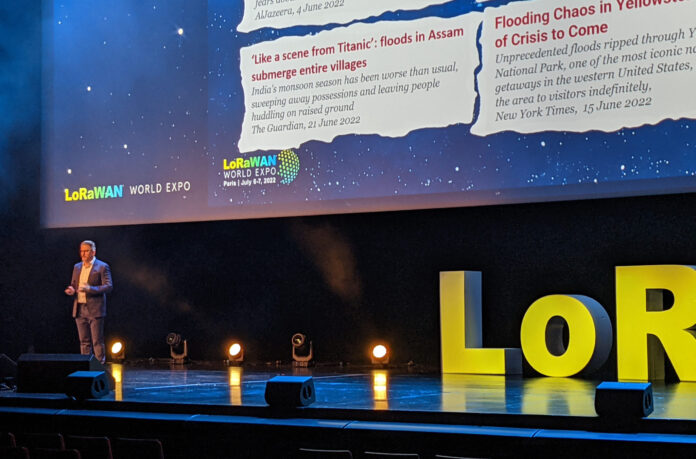Semtech, the steward of LoRa-based hardware production, picked up the baton at LoRaWAN World Expo last week (see more here: LoRaWAN goes [Iggy] pop) to further relay the message that low-power wide-area (LPWA) IoT technologies, headed by its own LoRaWAN entry, present the best chance for the planet to hurdle its desperate environmental targets, as set down in the UN’s sustainable development goals (SDGs) in 2015, and as adopted and interpreted by governments variously since.
The message from the US-based chipmaker was stark; anything else would have been wrong, but its keynote was designed also to mobilise the troops gathered in Paris to jointly-navigate a forward path. “Climate change is a topic that inspires fear, despair, denial – because of its enormous and far-reaching implications,” said Alistair Fulton, senior vice president and general manager of Semtech’s wireless and sensing group (which manages LoRa chip licensing).
Early summer, and, outside the Palais des Congrès, Paris was already heating up; at writing, parts of Europe are already set for another record-breaking heatwave. “Climate change is not slowing down, but accelerating… Concentrations of CO2 in May were 50 percent higher than during the pre-industrial era – levels not seen for four million years. Nine of the hottest years on human record have happened in the last 10 years,” Fulton said.
“If that is not a call for action, what is?” The future is already being told, in grim terms, he implied, across garage forecourts, urban food banks, desperate border crossings; it is being foreshadowed by war on European soil. “Unless we act, [a] scarcity of resources will become a source of conflict and war. This is the new reality…. And even with [government] commitments, we are not making progress fast enough,” said Fulton.
Invariably, and logically, this serious state-of-the-world address morphed into a fanfare for technology, and one technology in particular. “Solutions exist, and the architects of the future are searching for them… [But] we can’t wait; the time is now.” These solutions – enabled commonly by LoRaWAN-flavoured IoT, he said – are architected to make “more of less”; to enable population growth and economic growth at the same time as conserving resources.
LoRaWAN is already quite good at striking this productivity/efficiency balance, he said; the trick – made urgent by the stakes – is to scale IoT everywhere; to make it ‘massive’, as it was meant to be, by making it cheap, easy, and smart. Semtech (“as a member of the LoRaWAN ecosystem”) is committed to these ends, said Fulton, painting the US chipmaker as a cog in the broader LoRaWAN ecosystem, and an ally in the last-ditch mercy mission to save the future.
Decisive global change must come with the private sector, he said; government-level mandates and public-sector projects will not make the difference. “Regulation is important, but it won’t deliver the change we need. If we can align the interests of business… then we can create a model of more-for-less. Which is the founding principle of most commercial-enterprise. And IoT is the answer; no two ways [about it] – for intelligent growth, and sustainability.”
Of course (of course), LoRaWAN is the answer, really – said Fulton. “It’s an enabler, not a solution,” he said. And it works better because it does-better what wide-area IoT says on the tin; in so far as it delivers wide-area coverage and low-energy consumption (and therefore cheap connectivity), much like others, but also offers flexible deployment models (public, private; plus new community and satellite extensions), and easier integration and management.
All of these aspects – some newly available, all getting easier – will bring LoRaWAN to scale, faster than licensed cellular-based NB-IoT, or unlicensed Sigfox-et–al. That was the implication, and Semtech promised to push hard on behalf of all those licensing its IP to make it easier to grow it faster. “Our vision is wide scale adoption of IoT that uses the capabilities of LoRaWAN and other [IoT tech] to protect natural resources,” said Fulton.
“How many solutions? How many sensors? A lot. Let’s say a billion, because it’s a nice big number – to monitor supply chains, oceans, farms; to enable the intelligent use of the bounty of assets the earth has provided. We want to be part of that story – from fear, to hope and action, to deliver a new chapter and new future.”

